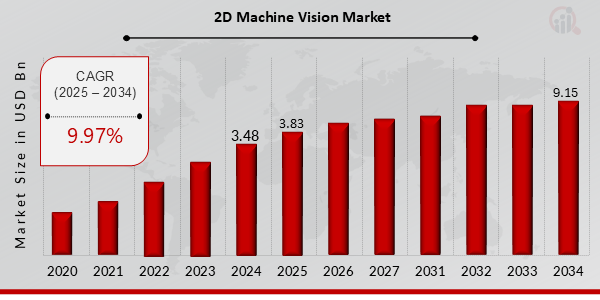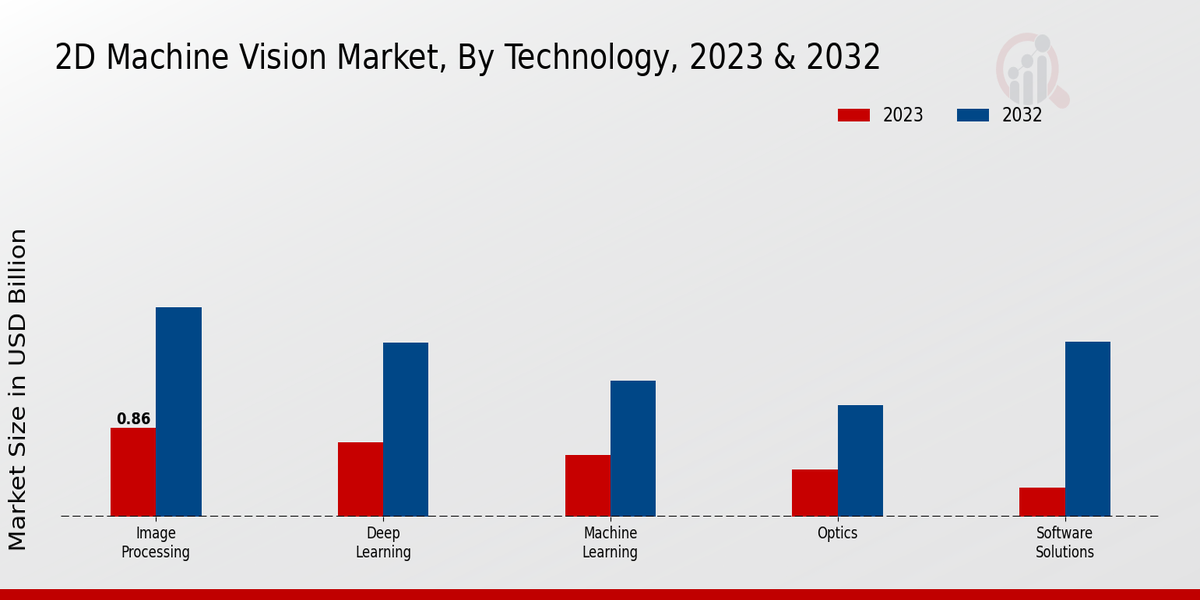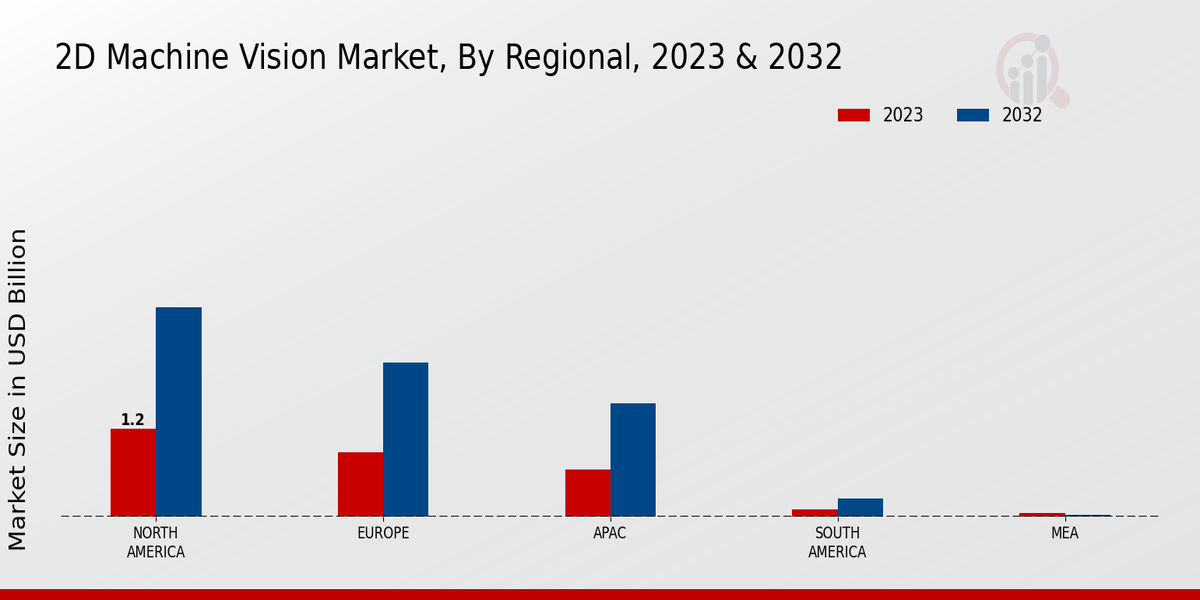Global 2D Machine Vision Market Overview:
2D Machine Vision Market Size was estimated at 3.48 (USD Billion) in 2024. The 2D Machine Vision Market Industry is expected to grow from 3.83 (USD Billion) in 2025 to 9.15 (USD Billion) till 2034, exhibiting a compound annual growth rate (CAGR) of 9.97% during the forecast period (2025 - 2034).
Key 2D Machine Vision Market Trends Highlighted
The 2D Machine Vision Market is driven by the increasing demand for automation across various industries, including manufacturing, automotive, and healthcare. The need for enhanced quality control and the capability to conduct high-speed inspections are significant factors pushing this growth. Additionally, as industries focus on improving operational efficiency, the adoption of 2D machine vision systems becomes vital for minimizing errors and ensuring consistent product quality. The declining costs of camera and sensor technologies also contribute to this trend, making machine vision more accessible to smaller companies.
Opportunities in the market lie in the continuous advancements in artificial intelligence and deep learning technologies. These innovations are leading to more sophisticated 2D machine vision systems that can process complex visual data with greater accuracy. There is also a growing interest in integrating machine vision with Internet of Things (IoT) solutions. This allows for real-time monitoring and data collection, which can provide deeper insights and drive smarter decision-making in industrial operations. Companies can also explore applications in emerging sectors such as robotics, where machine vision plays a critical role in navigation and interaction.
Recent trends indicate a shift towards the use of smart cameras and compact vision systems that are easy to integrate into existing processes. There is an increasing focus on software capabilities, allowing users to customize settings based on specific inspection requirements. The adoption of cloud computing is another notable trend, enabling better data storage and access to advanced analytics tools. Furthermore, sustainability is becoming a crucial factor, with companies aiming to reduce waste and energy consumption through more efficient machine vision solutions. Together, these trends signal a vibrant and evolving landscape for the 2D machine vision market.

Source: Primary Research, Secondary Research, MRFR Database and Analyst Review
2D Machine Vision Market Drivers
Increasing Adoption of Automation in Manufacturing Processes
The 2D Machine Vision Market Industry is experiencing significant growth due to the increasing adoption of automation across various manufacturing processes. Industries are continuously looking for ways to enhance operational efficiency, reduce labor costs, and improve product quality. Automated systems that incorporate 2D machine vision technologies allow for real-time monitoring of production lines, which aids in detecting defects, ensuring quality control, and minimizing waste.
With the escalating demand for precision and accuracy in manufacturing, companies are turning to 2D machine vision systems that can perform tasks such as part identification, measurement, and inspection at high speeds. Furthermore, as industries embrace Industry 4.0 and the Internet of Things (IoT), the integration of machine vision with automated manufacturing processes becomes essential.
This wave of technological advancement not only increases productivity but also provides valuable data analytics that organizations can utilize to make more informed decisions, ultimately leading to improved operational frameworks. As the trend towards complete automation continues, the demand for 2D machine vision solutions is anticipated to surge, releasing a cascade of opportunities within the 2D Machine Vision Market Industry.
Rising Demand for Quality Control in Various Industries
There is a rising demand for quality control mechanisms across various industries such as automotive, electronics, packaging, and food beverage. The need to maintain high quality standards has led to an increased adoption of 2D machine vision solutions. The 2D Machine Vision Market Industry is benefiting from this shift as organizations seek advanced technologies that can improve the accuracy and efficiency of quality inspections. These systems not only enable manufacturers to detect defects earlier in the production process but also assist in compliance with industry regulations and certification standards.
Technological Advancements in Machine Vision Systems
Technological advancements play a pivotal role in shaping the 2D Machine Vision Market Industry. Innovations such as enhanced imaging capabilities, artificial intelligence, and machine learning algorithms are driving the development of more sophisticated 2D machine vision solutions. These innovations are leading to improvements in speed, accuracy, and adaptability, enabling these systems to address a broader range of applications. As companies increasingly realize the competitive advantages offered by these advanced machine vision technologies, the demand for integrating them into existing processes is expected to rise significantly.
2D Machine Vision Market Segment Insights:
2D Machine Vision Market Technology Insights
The 2D Machine Vision Market, focusing on the Technology segment, has shown a robust growth trajectory, as reflected in its significant valuation. In 2023, the overall market is valued at 2.88 USD Billion, with expectations to reach 6.78 USD Billion by 2032. This growth is driven by an increasing demand for automation and quality inspection across various industries, highlighting the role that technology plays in enhancing productivity and efficiency. Among the various technological components, Image Processing emerges as a major player, valued at 0.86 USD Billion in 2023, projected to grow to 2.02 USD Billion by 2032.
Its significance lies in its ability to convert images into actionable information, making it essential for applications in manufacturing and robotics. Meanwhile, Deep Learning, which is valued at 0.72 USD Billion in 2023 and estimated to reach 1.68 USD Billion in 2032, is gaining traction due to its advanced capabilities in pattern recognition and predictive analysis, capable of transforming large datasets into meaningful insights.
Machine Learning also plays a pivotal role, valued at 0.60 USD Billion in 2023 and expected to grow to 1.31 USD Billion by 2032, as it underpins many automation systems through its ability to learn from data and improve outcomes over time.
Optics, with a value of 0.46 USD Billion in 2023, is anticipated to expand to 1.08 USD Billion by 2032, supporting the accuracy and clarity required for effective imaging systems, which is critical for safety and efficiency in various operational environments. Software Solutions, although currently valued at the lowest within this segment at 0.28 USD Billion in 2023, shows promising growth potential with an expected increase to 1.69 USD Billion by 2032, as software integration becomes vital in optimizing the functionality of machine vision systems.
This segment growth is indicative of a broader trend towards increased automation and intelligent systems, addressing the challenges of speed and precision in industrial applications. The 2D Machine Vision Market segmentation reveals not just the financial figures, but also underscores the essential roles that each technology plays in driving advancements within the industry. The interplay of these technologies continues to shape the landscape, presenting ample opportunities for innovation and applications across various sectors, ensuring that the demand for these solutions remains strong.
The interplay of advancements in these technologies serves as a catalyst for expanding the market and achieving higher operational efficiencies across manufacturing and other industries.

Source: Primary Research, Secondary Research, MRFR Database and Analyst Review
2D Machine Vision Market Application Insights
The 2D Machine Vision Market is poised for considerable growth, with a valuation of 2.88 USD Billion in 2023, driven by increasing technology adoption across various applications. The Application segment plays a crucial role, encompassing areas such as Quality Assurance, Robotics, Industrial Automation, Surface Inspection, and Security and Surveillance. Quality Assurance remains significant as industries focus on minimizing errors and ensuring product standards, which leads to enhanced operational efficiency. Meanwhile, Robotics has seen a rise in usage, with machine vision enabling precise tasks through automation, essential in modern manufacturing.
Industrial Automation leverages machine vision for real-time monitoring and control, thereby improving productivity. Surface Inspection is also integral as companies prioritize defect detection and product quality. Lastly, the Security and Surveillance aspect highlights the growing reliance on machine vision technology for enhancing safety protocols in various environments. As the 2D Machine Vision Market statistics reflect, the robust demand across these applications positions them as key contributors to the market's future trajectory.
2D Machine Vision Market End Use Insights
The 2D Machine Vision Market, valued at 2.88 USD Billion in 2023, showcases significant growth in various end-use sectors. Manufacturing plays a critical role, driving demand with efficiency and quality control applications. In the healthcare sector, 2D machine vision aids in enhancing diagnostic processes and ensuring precision in medical imaging. The automotive industry leverages this technology for inspection and quality assurance in production lines, resulting in fewer defects and improved safety. Electronics also heavily relies on machine vision for detailed inspection tasks, ensuring product reliability.
The food and beverage industry benefits from machine vision in quality assurance and packaging processes, ensuring compliance with safety standards. As industries continue to adopt automation and focus on quality improvement, the 2D Machine Vision Market segmentation reflects a diversified landscape where each application offers unique contributions, challenges, and opportunities. In the coming years, growth in these sectors is expected to drive the overall market expansion reflecting substantial 2D Machine Vision Market data and statistics.
2D Machine Vision Market Component Insights
The 2D Machine Vision Market is centered around various essential Components including Cameras, Sensors, Software, Lighting, and Frame Grabbers. In 2023, the market is valued at approximately 2.88 billion USD, with Components playing a crucial role in its overall functionality and effectiveness. Cameras, often regarded as the core of the system, capture images for analysis, contributing substantially to market growth. Sensors are vital for gathering data from the physical environment, while Software enables the processing and decision-making based on these inputs, thereby driving efficiency.
The Lighting Component is significant as it directly impacts image quality and system performance in varied industrial settings. Frame Grabbers facilitate the connection between the physical hardware and image processing systems, highlighting their importance in the assembly line. The demand for these Components is fueled by trends such as automation and increasing adoption of AI-powered systems across industries, enhancing manufacturing processes and operational efficiency.
However, challenges such as high implementation costs and the need for skilled personnel to operate these systems can hinder market growth. The 2D Machine Vision Market segmentation thus illustrates a diverse and interconnected ecosystem, with each Component contributing uniquely to the market dynamics.
2D Machine Vision Market Regional Insights
The 2D Machine Vision Market is experiencing notable regional variations in its revenue generation. In 2023, North America leads with a market valuation of 1.2 USD Billion, accounting for a majority holding as it benefits from advanced automation adoption and robust technological infrastructure. Europe closely follows with a valuation of 0.88 USD Billion, exhibiting significant growth driven by increasing demand in manufacturing and quality control. The APAC region, with a valuation of 0.65 USD Billion, is gaining momentum, reflecting the accelerating industrial activities and investments in machine vision solutions.
South America and MEA are relatively smaller markets, with valuations of 0.1 USD Billion and 0.05 USD Billion respectively in 2023. While South America's growth is hampered by economic fluctuations, MEA's market remains in its early development stages. The opportunities for growth in these regions hinge on the rising emphasis on automation and quality assurance across various industries, positioning the 2D Machine Vision Market for continued expansion across its diverse regional segments.

Source: Primary Research, Secondary Research, MRFR Database and Analyst Review
2D Machine Vision Market Key Players and Competitive Insights:
The 2D Machine Vision Market is characterized by intense competition and rapid technological advancements, driven by the increasing demand for automation across diverse industries. Key players are focusing on enhancing their product offerings with innovative technologies such as artificial intelligence, deep learning, and advanced imaging techniques. As companies strive to capture market share, they are also investing in research and development to create cutting-edge solutions that cater to specific operational needs such as quality control, robotic guidance, and inspection processes.
The market dynamics are influenced by factors such as evolving customer requirements, regional industrial growth, and the integration of machine vision systems with other technological innovations, which create a landscape filled with opportunities and challenges for existing and new entrants.
Dahua Technology has established a strong presence in the 2D Machine Vision Market, recognized for its high-performance imaging and automation solutions. The company’s strength lies in its comprehensive product portfolio, featuring cutting-edge cameras, image processing software, and system integration that address the requirements of various sectors, including manufacturing, automotive, and logistics. With a focus on innovation, Dahua Technology continuously enhances its technological capabilities, ensuring optimal image quality and processing efficiency. Furthermore, the company emphasizes reliability and customer support, which has bolstered its reputation among clients seeking robust machine vision solutions.
By strategically aligning with industry trends and investing in new technologies, Dahua Technology has positioned itself as a competitive force in the market.
National Instruments is another significant player in the 2D Machine Vision Market, offering a range of tools that facilitate the development of advanced imaging applications. The company is well-known for its powerful software platforms and hardware systems that support high-speed image acquisition, analysis, and processing. National Instruments stands out due to its flexibility in integrating machine vision systems with data acquisition and control solutions, allowing customers to develop tailored applications that meet specific needs.
Their emphasis on user-friendly interfaces and extensive training resources enhances the adoption of machine vision technologies among end-users. Furthermore, National Instruments actively collaborates with industry leaders, ensuring that their solutions remain aligned with current trends and standards. This collaborative approach, combined with their commitment to quality and performance, reinforces National Instruments' status as a prominent contributor to the 2D Machine Vision Market.
Key Companies in the 2D Machine Vision Market Include:
2D Machine Vision Industry Developments
The 2D Machine Vision Market has seen significant developments recently, with major players like Keyence, Cognex, and Basler expanding their product lines to enhance automation capabilities in various industries. Companies such as Dahua Technology and National Instruments are investing in advanced imaging technologies to improve quality inspection and process automation. Additionally, there's an increasing interest in AI-driven solutions, with firms like Teledyne Technologies and FLIR Systems focusing on integrating machine learning algorithms into their vision systems.
In terms of market consolidation, SICK AG announced a strategic partnership with ISRA VISION AG to leverage combined expertise in smart factory solutions, while Allied Vision is reported to have expanded its footprint by acquiring Vision Components, enhancing its capabilities in camera technology and industrial applications. Market valuation for companies in this sector continues to grow, driven by heightened demand for automation in manufacturing and logistics, contributing to the advancement of 2D machine vision technologies. This upward trend reflects the vital role of machine vision systems in optimizing operational efficiencies across sectors, including pharmaceuticals, automotive, and consumer electronics.
2D Machine Vision Market Segmentation Insights
2D Machine Vision Market Technology Outlook
2D Machine Vision Market Application Outlook
- Security and Surveillance
2D Machine Vision Market End Use Outlook
2D Machine Vision Market Component Outlook
2D Machine Vision Market Regional Outlook
| Report Attribute/Metric |
Details |
|
Market Size 2024
|
USD 3.48 Billion
|
|
Market Size 2025
|
USD 3.83 Billion
|
|
Market Size 2034
|
USD 9.15 Billion
|
|
Compound Annual Growth Rate (CAGR)
|
9.97% (2025-2034)
|
| Report Coverage |
Revenue Forecast, Competitive Landscape, Growth Factors, and Trends |
|
Base Year
|
2024
|
|
Market Forecast Period
|
2025-2034
|
|
Historical Data
|
2020-2023
|
| Market Forecast Units |
USD Billion |
| Key Companies Profiled |
Dahua Technology, National Instruments, Keyence, Matrix Vision, JAI A/S, Vision Components, SICK AG, ISRA VISION AG, Allied Vision, Sony, Cognex, Basler, Teledyne Technologies, Omron, FLIR Systems |
| Segments Covered |
Technology, Application, End Use, Component, Regional |
| Key Market Opportunities |
Rising automation in manufacturing, Increasing demand for quality control, Growth in robotics applications, Expansion in semiconductor industry, Adoption in healthcare diagnostics |
| Key Market Dynamics |
Technological advancements, Increased automation demand, Cost reduction strategies, Growing applications in industries, Rising need for quality control |
| Countries Covered |
North America, Europe, APAC, South America, MEA |
Frequently Asked Questions (FAQ):
The 2D Machine Vision Market is expected to be valued at 9.15 USD Billion by 2034.
The 2D Machine Vision Market is projected to grow at a CAGR of 9.97% from 2025 to 2034.
North America is expected to hold the largest market share, valued at 2.85 USD Billion by 2032.
Key players in the market include Dahua Technology, National Instruments, Keyence, and Cognex.
For 2023, the market is segmented into Image Processing, Deep Learning, Machine Learning, Optics, and Software Solutions.
The Image Processing segment of the 2D Machine Vision Market is expected to be valued at 2.02 USD Billion by 2032.
The APAC region is expected to reach a market size of 1.55 USD Billion by 2032.
The Software Solutions segment is anticipated to be valued at 1.69 USD Billion by 2032.
Main growth drivers include increasing automation in industries and advancements in imaging technologies.
The South American segment is expected to grow to a market size of 0.25 USD Billion by 2032.

















